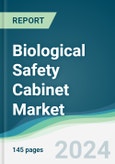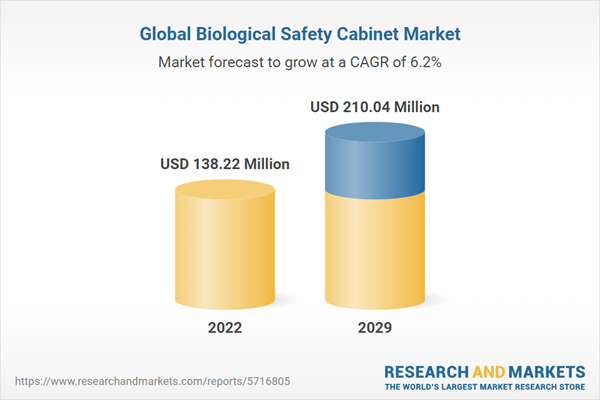The biological safety cabinet market is evaluated at US$138.221 million for the year 2022 and is projected to grow at a CAGR of 6.16% to reach a market size of US$210.036 million by the year 2029.
A biological safety cabinet is an enclosed cabinet used in laboratories and research centers to protect scientists and laboratory personnel from any biohazard or infectious agents that occur during the processing of contaminated materials. The cabinet is equipped with a highly efficient particle-arresting filter (HEPA) which removes infection agents such as viruses & bacteria from the air in the laboratory. Owing to its high safety and performance features, the biological safety cabinet holds high applicability in testing & diagnostic laboratories of pharmaceutical companies and research institutes.The bolstering growth in the pharmaceutical sector, owing to the growing demand for new and effective medical drugs for diseases, and favorable investment inflows both by companies and government organizations have positively impacted the market growth of the biological safety cabinet. Such investments are predicted to increase the demand for biological safety cabinets during the drug testing application, thereby boosting the market for the cabinets during the forecast period.
MARKET TRENDS:
The rising adoption of IP-based services over traditional PSTN services is projected to boost the market growth during the forecast period. Factors such as increasing usage of cloud computing, rapid adoption of cloud, and unified communication systems by enterprises are expected to increase the demand for Biological safety cabinets, thus boosting the overall market growth. The Biological safety cabinet market has been segmented based on enterprise size, end-user, and geography. Based on enterprise size, the market has been segmented into small, medium, and large. By end-user, the market has been segmented into communication and technology, healthcare, retail, BFSI, government, and others.MARKET DRIVERS:
Favorable investment inflows and collaborations in the life sciences industry are predicted to create a surge in the demand for biological safety cabinets.
Biological safety cabinet owing to their safety features is majorly used in biological laboratories, research, and microbiology for personnel as well as environmental protection. Various pharmaceutical companies are undergoing strategic collaborations as well as investments in new drugs and vaccine development that could cater to the unmet needs of people suffering from major diseases. Furthermore, in March 2022, Blackstone Life Sciences entered into a strategic collaboration with Sanofi, for the development of the treatment for multiple myeloma. Such establishment and investments are anticipated to stimulate the demand for biological safety cabinets, thereby boosting its market growth during the forecast period.A rising focus on laboratory safety is predicted to positively influence the market.
The biological safety cabinets (BSCs) market is significantly impacted by the growing emphasis on laboratory safety, which fuels a spike in demand for these essential containment systems. BSCs are essential parts of safety protocols as labs and research facilities put workers' health first and work to reduce the hazards involved in handling biological materials.The strict observance of the rules and guidelines controlling biosafety is indicative of the emphasis on laboratory safety. BSCs offer a controlled environment that avoids contamination and cross-contamination during tests and processes since they are particularly made to comply with these strict criteria. The adoption of cutting-edge BSC technologies is fueled by the increased awareness of possible risks, which highlights the necessity for dependable containment solutions.
MARKET RESTRAINTS:
There are significant limitations faced by the biological safety cabinet (BSC) industry that may affect its broader acceptance. The major challenge is the initial high expense of buying, installing, and certifying BSCs. The substantial monetary outlay that is necessary might be prohibitive for labs and medical facilities, especially those with tight budgets.The total cost of ownership is further impacted by continuing operating and maintenance costs, such as frequent certification and testing to guarantee adherence to safety regulations. The decision-making process of smaller laboratories or institutions with limited resources may be impacted by this cost burden. Furthermore, the requirement for certification and frequent maintenance might cause downtime, which would disrupt the ongoing operation in settings like hospitals and research facilities.
The biological safety cabinet is anticipated to be the fastest-growing segment.
Based on class type, the biological safety cabinet is segmented into class I, class II, and class III. The class II type biological safety cabinet is expected to grow at a relatively higher rate during the forecast period of the biological safety cabinet market. Class II biological safety cabinet has high usage in basic research and testing activities, and as it is equipped with a HEPA filter, the cabinet provides better protection to products, personnel, and the environment. With the growing establishment of R&D facilities for new drug production and testing, the demand for such cabinets is also expected to increase. Furthermore, owing to various investments in R&D for new drug development, the demand for class II biological safety cabinets is also projected to increase.Asia Pacific is anticipated to be the major regional market.
The Asia Pacific biological safety cabinet (BSC) market is driven by various factors that coincide with the rapidly expanding fields of biotechnology and life sciences research. Strong biosafety protocols must be put in place since the number of facilities conducting genetic research, medication development, and diagnostics is rapidly growing in the area. The need for BSCs is further fueled by government programs and significant expenditures in research and development, which are in line with the region's commitment to promoting innovation and scientific developments.Healthcare institutions and laboratories are incorporating BSCs into their safety measures because of the growing awareness of the possible hazards involved in handling biological materials and the requirement to adhere to international biosafety standards. The dynamic field of scientific research in the Asia Pacific area highlights the importance of BSCs as essential instruments for guaranteeing a safe workplace, thus fostering the expansion and improvement of biosafety protocols in many sectors.
Key Developments:
- In June 2023, the labculture® G4 Class II Type A2 Biological Safety Cabinet (LA2 G4) raised the bar for innovation and perfection in biosafety cabinet technology. This state-of-the-art biosafety cabinet, an NSF-certified BSC, established a new benchmark for efficiency and safety. It is made to guarantee the protection of both users and products while offering an exceptional degree of containment.
- In March 2023, with the advent of the ReVoTM, an additional cutting-edge microbiological safety cabinet, Labconco® expanded its wide range of biosafety products. ReVo is a new Class II, Type A2 biosafety solution that has been carefully designed.
Segmentation:
By Class Type
- Class I
- Class II
- Class III
By Application
- Pathogenic Samples Handling
- Research & Development Applications
By End-User
- Testing & Diagnostic Laboratories
- Research Institutes
By Geography
- North America
- USA
- Canada
- Mexico
- South America
- Brazil
- Argentina
- Others
- Europe
- United Kingdom
- Germany
- France
- Spain
- Others
- Middle East and Africa
- Saudi Arabia
- UAE
- Israel
- Others
- Asia Pacific
- China
- Japan
- India
- South Korea
- Taiwan
- Thailand
- Indonesia
- Others
Table of Contents
1. INTRODUCTION
2. RESEARCH METHODOLOGY
3. EXECUTIVE SUMMARY
4. MARKET DYNAMICS
5. BIOLOGICAL SAFETY CABINET MARKET, BY CLASS TYPE
6. BIOLOGICAL SAFETY CABINET MARKET, BY APPLICATION
7. BIOLOGICAL SAFETY CABINET MARKET, BY END-USER
8. BIOLOGICAL SAFETY CABINET MARKET, BY GEOGRAPHY
9. COMPETITIVE ENVIRONMENT AND ANALYSIS
10. COMPANY PROFILES
Companies Mentioned
- Esco Micro Pte. Ltd
- Kewaunee International Group
- Thermo Fisher Scientific
- Baker
- Labconco
- Germfree Laboratories Inc. (EW Healthcare Partners)
- Nuarie (Genuit)
- Euroclone S.p.A
- Air Science
Methodology

LOADING...
Table Information
| Report Attribute | Details |
|---|---|
| No. of Pages | 145 |
| Published | February 2024 |
| Forecast Period | 2022 - 2029 |
| Estimated Market Value ( USD | $ 138.22 Million |
| Forecasted Market Value ( USD | $ 210.04 Million |
| Compound Annual Growth Rate | 6.1% |
| Regions Covered | Global |
| No. of Companies Mentioned | 9 |









